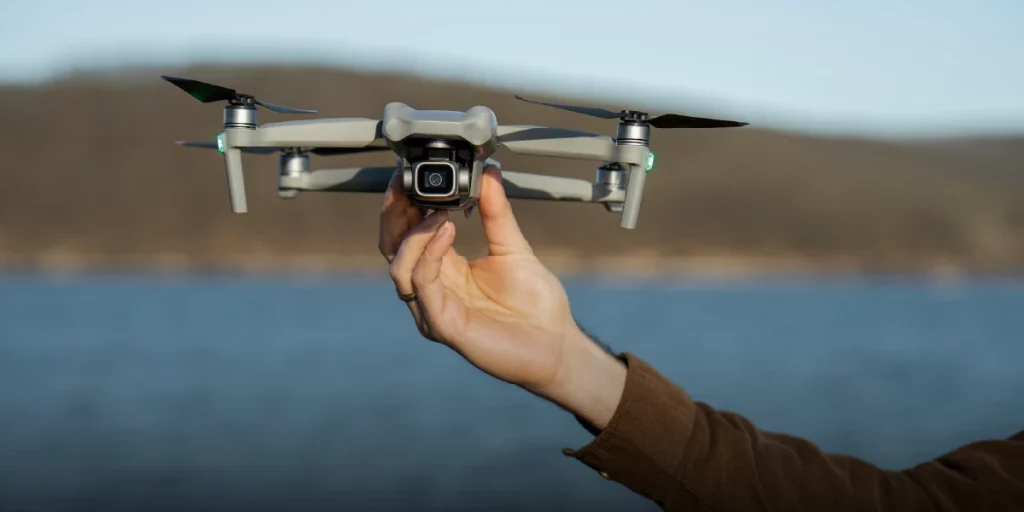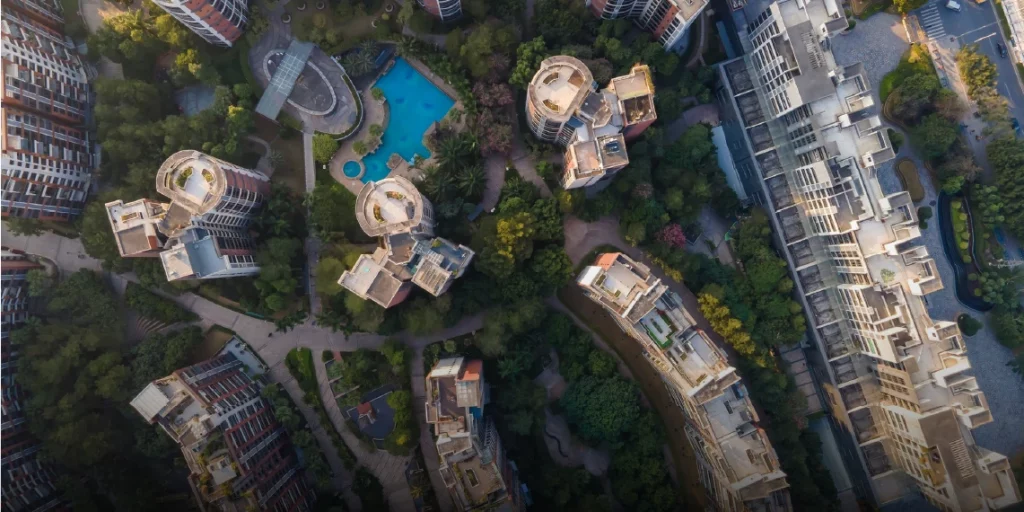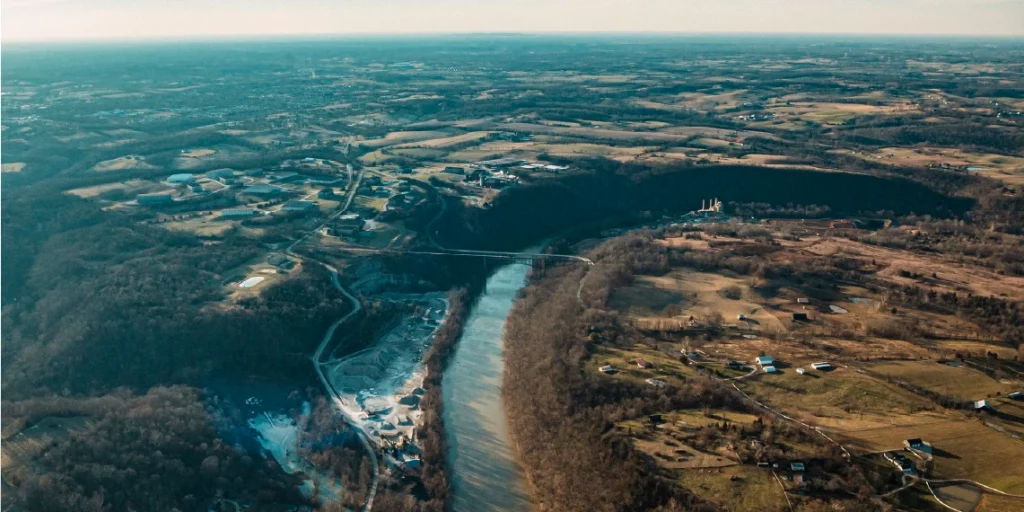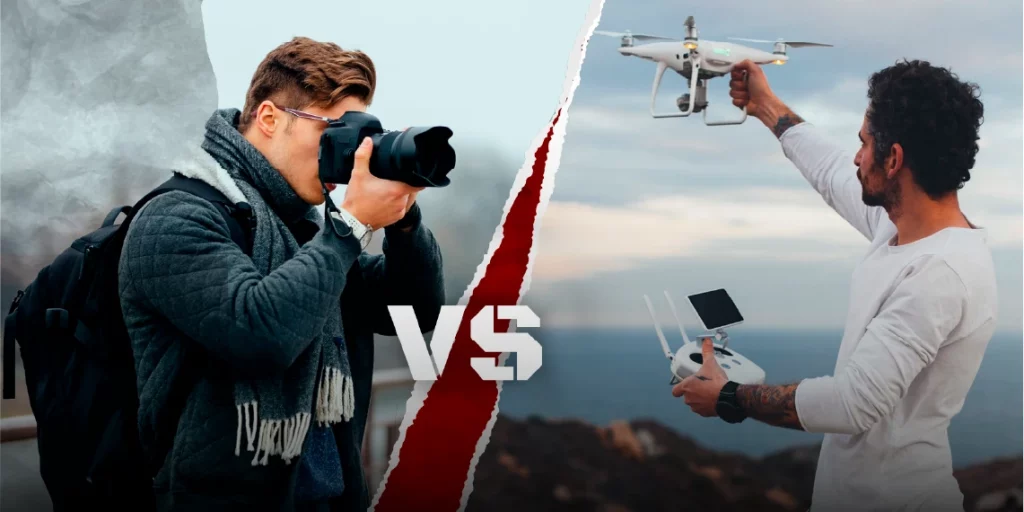The first impression of Real Estate can make or break a deal. The significance of captivating visuals of real estate drone photography cannot be overstated. As technology continues to redefine the way we experience and interact with the world, real estate professionals are leveraging innovative tools to showcase properties in the best possible light. One such groundbreaking technology that has revolutionised the way we view real estate is drone photography, particularly in capturing stunning aerial views.
The real estate industry has witnessed a paradigm shift in marketing strategies, with a growing emphasis on visually appealing content. Gone are the days when static images from ground-level shots sufficed to pique the interest of potential buyers. Drone photography is a game-changer in residential drone photography and commercial drone photography that elevates property marketing to new heights, quite literally. This cutting-edge technology provides a unique perspective that traditional photography simply cannot match.
The allure of drone photography lies in its ability to offer breathtaking aerial views of properties, showcasing them from once-inaccessible angles. Drones equipped with high-resolution cameras can effortlessly capture the grandeur of expansive estates, the architectural intricacies of modern skyscrapers, or the charm of quaint suburban neighbourhoods. The result is a visually striking portfolio that not only highlights the property’s features but also provides a sense of scale and context that is often lost in ground-level photographs.
What is Drone Photography?

Drone photography involves the use of unmanned aerial vehicles (UAVs), commonly known as drones, equipped with cameras to capture images or videos from an elevated vantage point. These drones are remotely controlled by operators on the ground, enabling them to navigate and position the camera at various angles and heights. The development of compact, high-quality cameras and advanced stabilisation technology has played a pivotal role in making drone photography accessible to enthusiasts, professionals, and industries alike.
Drone photography in recent years has emerged as a revolutionary technology, transforming the way we capture and perceive the world around us. This aerial imaging technique has opened up new possibilities, providing a unique perspective that was once reserved for the realms of aviation and cinematography. In this article, we will delve into the definition and explanation of drone photography, explore the unique perspective offered by aerial views, and compare it with traditional ground-level photography.
The primary advantage of drone photography lies in its ability to capture visuals from perspectives that were once impractical or impossible. Drones can reach heights and angles that conventional cameras or photographers cannot, allowing for a diverse range of shots, from sweeping landscapes to intimate details. This technology has found applications in various fields, including real estate, agriculture, journalism, and filmmaking.
The Shift to Visual Marketing in Real Estate
The real estate industry has undergone a significant transformation in its marketing strategies, with a notable shift towards visual marketing. This evolution can be attributed to changing consumer preferences, advancements in technology, and the increasing importance of creating engaging and immersive experiences for potential buyers. In this article, we will explore the changing landscape of real estate marketing, the impact of visuals on potential buyers, and the need for innovative tools in property marketing.
Changing Marketing Strategies in the Real Estate Industry
Traditionally, real estate marketing relied heavily on text-based descriptions, floor plans, and static images. However, the modern consumer is more visually oriented and seeks dynamic, immersive experiences. This shift in consumer behaviour has prompted real estate professionals to adapt their marketing strategies to include a more visual approach.
One of the key drivers behind this change is the rise of social media platforms and visual-centric websites. Platforms like Instagram, Pinterest, and YouTube have become powerful tools for real estate marketing. Real estate agents and property developers now leverage these platforms to showcase properties through high-quality images, virtual tours, and videos. This shift reflects the industry’s recognition that visually appealing content can capture the attention of potential buyers more effectively than traditional methods.
The Impact of Visuals on Potential Buyers
The human brain processes visuals faster than text, and in the competitive real estate market, making a lasting impression is crucial. High-quality images, 3D virtual tours, and video content allow potential buyers to experience a property remotely, creating a sense of connection and increasing the likelihood of a site visit.
Visuals not only help in showcasing the physical attributes of a property but also contribute to storytelling. A well-curated visual presentation can convey the lifestyle associated with a property, highlighting its unique features and selling points. This emotional connection can significantly influence a buyer’s decision-making process.
Moreover, visuals play a vital role in building trust. Authentic and transparent representation of properties through visuals fosters trust between buyers and sellers. Buyers are more likely to engage with listings that provide a comprehensive visual overview, reducing the uncertainty associated with property purchases.
The Need for Innovative Tools in Property Marketing
As the demand for visual content in real estate marketing grows, there is a corresponding need for innovative tools and technologies to create and deliver compelling visuals. Virtual reality (VR) and augmented reality (AR) are emerging as game-changers in the industry. These technologies enable users to experience properties in a highly immersive manner, virtually walking through spaces and visualising potential modifications.
Drones have also become valuable tools for capturing breathtaking aerial shots of properties and their surroundings. This technology provides a unique perspective, allowing potential buyers to get a better sense of the property’s location, layout, and surrounding amenities.
In addition to these, AI-powered tools are being used to enhance the editing and customization of visual content. Automated video editing, image enhancement, and virtual staging are examples of how artificial intelligence is streamlining the creation of visually appealing marketing materials.
Significance of Real Estate Drone Photography

In the fast-evolving world of real estate marketing, staying ahead of the competition is essential. One innovative tool that has revolutionised the way properties are showcased is drone photography. Unmanned Aerial Vehicles (UAVs), commonly known as drones, equipped with high-quality cameras, offer a unique perspective that traditional photography cannot match.
The significance of real estate drone photography emphasises how it enhances property marketing and captivates potential buyers.
Capturing Breathtaking Aerial Views
One of the most striking advantages of real estate drone photography is the ability to capture breathtaking aerial views. Drones provide a bird’s-eye perspective that showcases the property and its surroundings in a way that ground-level photography cannot achieve. Aerial shots offer a comprehensive view of the entire property, highlighting its layout, landscaping, and proximity to key features such as parks, water bodies, or urban amenities.
This elevated perspective not only adds a touch of luxury to property presentations but also provides potential buyers with a clear understanding of the property’s overall appeal. Aerial views can be especially beneficial for larger properties, estates, or those situated in scenic locations, allowing potential buyers to envision themselves in a serene and picturesque environment.
Showcasing Properties from Inaccessible Angles
Drone photography excels at showcasing properties from angles that would otherwise be inaccessible or challenging to capture. For instance, properties with expansive landscapes, intricate architectural details, or unique features can be effectively highlighted through aerial shots. Drones can navigate around the property, providing a comprehensive view of every angle, and ensuring that potential buyers get a complete and detailed perspective.
This advantage is particularly valuable for properties with expansive grounds, intricate landscaping, or distinctive architectural elements. By showcasing these features from unique vantage points, drone photography allows real estate listings to stand out, capturing the attention of prospective buyers and creating a lasting impression.
Providing a Sense of Scale and Context
Real estate drone photography offers the invaluable benefit of providing a sense of scale and context. When potential buyers view a property from the air, they can better understand its size, proportions, and relation to neighbouring properties and amenities. This aerial perspective helps buyers gauge the overall layout and visualise the property’s place within the surrounding environment.
Whether it’s a sprawling estate with vast grounds, a waterfront property with private access, or a high-rise condominium with stunning city views, drone photography contextualises the property within its surroundings. This not only aids buyers in making informed decisions but also instils confidence by offering a transparent and comprehensive portrayal of the property.
Creating a Compelling Narrative for Properties
In the competitive real estate market, storytelling plays a crucial role in capturing the imagination of potential buyers. Real estate drone photography contributes significantly to creating a compelling narrative for properties. By weaving together a series of aerial shots, ground-level images, and seamlessly transitioning video footage, a visual story can be crafted that showcases the property’s unique features and lifestyle offerings.
The dynamic nature of drone photography allows for the creation of engaging property videos that highlight key selling points, architectural details, and the overall ambience. This visual storytelling not only attracts attention but also emotionally resonates with potential buyers, making them more likely to connect with the property on a personal level.
Unique Perspective Offered by Aerial Views

One of the most compelling aspects of drone photography is the unique perspective it offers through aerial views. Traditionally, photographers have been limited to ground-level compositions, but drones elevate the game by providing a bird’s-eye view of the world. This perspective adds a new dimension to visual storytelling, allowing photographers to convey a sense of scale, patterns, and context that is often hidden from the ground.
In landscape photography, for example, drones can capture vast panoramas with breathtaking detail, showcasing natural wonders, urban sprawls, or architectural marvels in their entirety. This aerial perspective is equally valuable in real estate, where potential buyers can gain a comprehensive understanding of a property’s layout, surroundings, and features. Additionally, in agriculture, farmers utilize drone imagery to monitor crop health, assess field conditions, and optimize resource management.
Beyond practical applications, drone photography has become an art form in itself. The ability to capture images from unconventional angles and heights allows for creative expression and experimentation. Photographers can play with shadows, symmetry, and juxtaposition in ways that were previously challenging or impossible, resulting in visually stunning and thought-provoking compositions.
Comparison of Drone Photography with Traditional Ground-Level Photography

While drone photography offers unparalleled perspectives, it is essential to recognize the unique qualities of traditional ground-level photography. Each approach has its strengths, and the choice between them depends on the context, objectives, and desired visual impact.
Ground-level photography excels in capturing human-scale perspectives, emphasising details, emotions, and intimate moments. It remains the preferred choice for street photography, portraits, and scenes that require a close connection with the subject. On the other hand, drone photography provides a broader context, making it ideal for showcasing vast landscapes, architectural marvels, and environmental changes over time.
In terms of accessibility, ground-level photography is often simpler and more cost-effective. Drones come with a learning curve and regulatory considerations, including airspace restrictions and safety concerns. Additionally, traditional photography allows for spontaneity, as photographers can quickly capture moments without the need for pre-flight preparations.
Benefits of Real Estate Drone Photography

Real estate drone photography has become a game-changer in the industry, offering stunning visuals and unique perspectives that traditional photography simply can not match.
Below mentioned are the benefits of using drones for real estate photography:
1. Breathtaking Aerial Views: Drones can soar high above properties, capturing panoramic vistas that showcase the entire landscape, surrounding amenities, and the relationship between the property and its environment. This bird’s-eye view creates a sense of grandeur and helps potential buyers envision themselves living in the space.
2. Enhanced Property Features: Drone photography can highlight unique features of a property that might be missed from ground level. This includes expansive backyards, swimming pools, intricate rooflines, or even the layout of a vineyard or golf course. These details add depth and dimension to the listing, making it more engaging and memorable for potential buyers.
3. Virtual Tours and Storytelling: Drone footage can be stitched together to create immersive virtual tours, allowing potential buyers to virtually explore a property at their own pace. This is especially beneficial for high-end properties or those located in remote areas. Drones can also capture unique video angles and movements, adding a cinematic element to property listings and telling a more compelling story about the space.
4. Increased Engagement and Interest: Listings with drone photography are proven to generate more interest and engagement from potential buyers. Studies have shown that drone photos can increase click-through rates by up to 47% and lead to faster sales. The unique and visually stunning nature of drone footage simply grabs attention and makes properties stand out in a crowded market.
5. Cost-Effective Marketing Tool: Compared to traditional aerial photography methods like helicopters, drones offer a much more cost-effective solution. They are also more time-efficient and can capture a wider range of shots in a shorter amount of time. This makes drone photography a valuable investment for real estate agents and property owners alike.
6. Improved Safety and Access: Drones can access hard-to-reach areas of a property, such as rooftops or cliffs, without putting anyone at risk. This can be especially helpful for inspecting properties with challenging terrain or for showcasing unique architectural features.
7. Competitive Advantage: In today’s competitive real estate market, using drone photography can give you a significant edge over your competitors. Listings with high-quality aerial shots are more likely to attract attention and generate interest, ultimately leading to faster sales and higher asking prices.
Efficiency in the Real Estate Marketing Process
Efficiency in the real estate marketing process is crucial for success in a competitive industry. To stay ahead and attract potential buyers, real estate professionals must adopt strategies that ensure rapid and cost-effective production of high-quality imagery, streamline the photography process with diverse angles, and achieve quicker turnaround times for marketing materials.
These elements contribute to a more effective and competitive real estate marketing campaign.
Rapid and cost-effective production of high-quality imagery
In the digital age, visuals play a pivotal role in attracting prospective buyers. High-quality imagery is essential for showcasing properties in the best light and making a lasting impression. Rapid and cost-effective production of such imagery is a key factor in the efficiency of the real estate marketing process.
To achieve this, real estate professionals can leverage advanced technologies such as drones and virtual tour software. Drones provide a cost-effective way to capture stunning aerial shots of a property and its surroundings. This not only adds a unique perspective but also enhances the overall visual appeal of the property. Additionally, virtual tour software allows potential buyers to explore properties remotely, saving time for both buyers and sellers.
Moreover, outsourcing photography and image editing services can be a cost-effective solution. Professional photographers and editors can ensure that the visual content is of the highest quality, leaving real estate agents and marketers to focus on their core tasks. This approach not only saves time but also ensures that the marketing materials stand out in a crowded market.
Streamlining the photography process with diverse angles
Variety in visual content is key to capturing the attention of potential buyers. A single, standard angle may not do justice to the unique features of a property. Therefore, streamlining the photography process with diverse angles is essential for an effective real estate marketing campaign.
Photographers can use wide-angle lenses to capture more of a room in a single shot, providing a comprehensive view of the space. Additionally, utilising different perspectives, such as low-angle shots to highlight architectural details or high-angle shots to showcase the surrounding landscape, adds depth to the visual representation of a property.
Automation tools and software can further streamline the photography process. These tools can assist in scheduling photoshoots, managing equipment, and even editing images automatically. By reducing manual intervention, real estate professionals can save time and ensure a more efficient workflow.
Quicker turnaround times for marketing materials
In the fast-paced real estate market, time is of the essence. Quicker turnaround times for marketing materials can make a significant difference in attracting potential buyers and closing deals promptly. Real estate agents need to strike a balance between speed and quality to stay competitive.
Utilising templates for marketing materials, such as brochures and social media posts, can expedite the content creation process. Ready-made templates allow for quick customization while maintaining a professional and cohesive visual identity.
Collaboration tools and cloud-based platforms facilitate seamless communication and file sharing among team members, reducing delays in the approval and distribution of marketing materials. Cloud storage also ensures that all team members have access to the latest versions of files, preventing miscommunication and errors.
Enhancing Visual Storytelling
In the competitive realm of real estate, where first impressions matter the most, enhancing visual storytelling has become a pivotal aspect for capturing the attention of potential buyers. The traditional approach of static images and mundane descriptions is gradually giving way to a more cinematic and immersive experience, bringing listings to life and differentiating properties in a crowded market.
Cinematic Quality Added to Visual Storytelling
One of the key elements transforming the landscape of real estate marketing is the infusion of cinematic quality into the visual storytelling of listings. Traditionally, property listings relied heavily on static images that often failed to convey the true essence of a space. However, with advancements in technology and the availability of high-quality cameras, real estate professionals are now able to create cinematic experiences that showcase properties in a more compelling light.
Cinematic storytelling involves carefully curated shots, dynamic camera movements, and attention to detail that goes beyond what static images can offer. Through the use of techniques such as drone footage, smooth panning, and creative editing, real estate videos can now emulate the atmosphere and flow of a movie. This not only captures the viewer’s attention but also provides a more immersive experience, allowing potential buyers to envision themselves in the space.
Immersive and Engaging Nature of Aerial Views
Aerial views have emerged as a powerful tool in elevating the visual storytelling of real estate listings. Drones equipped with high-resolution cameras enable the capture of breathtaking aerial footage, offering a unique perspective that was previously inaccessible. This immersive approach not only showcases the property itself but also provides a comprehensive view of the surrounding neighbourhood, landscape, and amenities.
Aerial views are particularly effective in highlighting the property’s proximity to key landmarks, schools, parks, and other points of interest. This not only adds value to the listing but also aids potential buyers in understanding the context of the property within its environment. The engaging nature of aerial views creates a sense of exploration and discovery, making the viewing experience more memorable and encouraging prospective buyers to explore the property further.
Differentiating Properties in a Crowded Market
In a saturated real estate market, differentiation is crucial for standing out and attracting potential buyers. Visual storytelling plays a pivotal role in achieving this by conveying the unique features and qualities of each property. By adopting a cinematic approach and incorporating immersive elements, real estate professionals can effectively differentiate their listings from the competition.
High-quality visuals not only showcase the physical attributes of a property but also communicate its lifestyle and character. This is essential in catering to the diverse preferences of potential buyers. Whether it’s the warm ambience of a cosy living room, the panoramic views from a rooftop terrace, or the vibrant energy of a bustling neighbourhood, visual storytelling allows for a more nuanced and personalized presentation of each property.
Strategies for Staying Competitive in the Real Estate Market
Staying ahead in the competitive real estate market requires a strategic approach that combines innovation, technology, and a deep understanding of client needs. To thrive in this dynamic industry, real estate professionals must embrace creative solutions that set their listings apart, cater to the evolving preferences of clients, and create lasting impressions.
Three key strategies to stay competitive in the real estate market are mentioned below:
Setting Listings Apart with Stunning Drone Photography
In an age where visuals play a crucial role in decision-making, leveraging luxury drone photography has become a game-changer in the real estate industry. Drones offer a unique perspective, capturing stunning aerial shots that showcase the property and its surroundings in a way traditional photography cannot. This not only provides potential buyers with a comprehensive view of the property but also adds a touch of sophistication to the listing.
The use of drone photography is particularly effective for highlighting features such as expansive landscapes, architectural details, and the overall layout of a property. Whether it’s a sprawling estate with vast grounds or a modern urban condominium with breathtaking skyline views, drone photography elevates the presentation, making the property more attractive to prospective buyers.
In addition to enhancing the visual appeal, drone photography can also aid in highlighting neighborhood amenities, and showcasing proximity to schools, parks, and other local attractions. This comprehensive view assists potential buyers in making informed decisions, thereby increasing the likelihood of a successful transaction.
Meeting the Demand for Interactive and Visually Appealing Content
In today’s digital age, buyers crave interactive and visually appealing content. Real estate professionals need to go beyond static images and embrace technologies that engage potential clients. Virtual tours, 3D floor plans, and interactive maps provide a more immersive experience, allowing prospective buyers to explore a property from the comfort of their homes.
Virtual reality (VR) and augmented reality (AR) technologies are gaining traction, offering innovative ways to showcase properties. These technologies enable clients to virtually walk through a property, visualize renovations, and even furnish spaces according to their preferences. By incorporating interactive and immersive content, real estate professionals can cater to the preferences of a tech-savvy audience, giving their listings a competitive edge.
Creating a Lasting Impact on Clients
Beyond the initial interaction, creating a lasting impact on clients is essential for building a successful real estate business. This involves delivering exceptional customer service, building strong relationships, and maintaining open communication throughout the buying or selling process.
Personalization is key to creating a lasting impact. Understanding the unique needs and preferences of each client allows real estate professionals to tailor their approach and provide a memorable experience. This could include sending personalized property recommendations, offering insightful market insights, and addressing any concerns promptly.
Moreover, maintaining a strong online presence and leveraging social media platforms can enhance client engagement. Regular updates, market trends, and informative content not only showcase expertise but also keep clients informed and engaged. Utilizing CRM (Customer Relationship Management) tools can also help in managing client relationships efficiently, ensuring that no opportunity is overlooked.
Frequently Asked Questions
Drone photography in real estate involves using UAVs with cameras to capture aerial views of properties.
Drone photography offers aerial perspectives, showcasing unique features and adding a cinematic element which is not achievable with ground-level methods.
Drone photography in real estate enhances property marketing with breathtaking aerial views, and unique perspectives, and contributes to compelling visual storytelling.
The benefits of drone photography include capturing aerial views, showcasing unique features, creating virtual tours, increasing engagement, cost-effectiveness, improved safety, and gaining a competitive advantage.
Drone photography provides cinematic quality, and immersive aerial views, and helps create a compelling narrative that differentiates properties in the market.
Yes, operators must comply with local regulations and obtain necessary permissions for responsible and legal drone use.
The innovative tools such as VR, AR, and AI-powered tools enhance immersive experiences, and customization of visual content, and contribute to a more advanced marketing approach.
Drone Photography contributes to efficiency by rapidly producing high-quality imagery, streamlining photography with diverse angles, and facilitating quicker turnaround times for marketing materials.
Personalization in real estate drone photography is crucial for understanding unique client needs, tailoring approaches, providing exceptional service, and building lasting relationships.
The future outlook for drone technology is expected to bring exponential growth with advancements in videography, 3D mapping, and virtual reality, reshaping the industry’s visual exploration boundaries.
Conclusion
In conclusion, the integration of drone technology has revolutionised real estate, transforming how properties are presented and transactions occur. Drone photography signifies a shift from static images to dynamic, immersive perspectives. This innovation provides potential buyers with stunning aerial views showcasing not only the property but also its surroundings, neighbourhood amenities, and proximity to essential services.
Drone technology serves as a powerful storytelling tool for real estate professionals, enabling them to craft compelling narratives that emotionally resonate with potential buyers. The move towards immersive storytelling establishes a deeper connection by offering comprehensive views of a property’s layout, landscaping, and exterior features. In the digital age where online platforms dominate property exploration, drone photography stands out as a crucial differentiator, capturing attention in a crowded digital marketplace and setting a standard for excellence in real estate marketing.
Embracing innovation, especially through drone technology, is not just a choice but a strategic necessity for staying ahead in the competitive real estate market. Real estate professionals leveraging drones demonstrate a commitment to providing an unparalleled experience for their clients, streamlining the buying process, enhancing marketing efforts, and ultimately leading to quicker sales.
Looking ahead, the continued relevance and impact of drone technology in real estate marketing are expected to grow exponentially. Advancements in videography, 3D mapping, and virtual reality experiences further enhance immersive storytelling capabilities, allowing potential buyers to virtually explore properties. Drones equipped with advanced sensors provide valuable data on property conditions, reinforcing transparency and professionalism in the industry.
Drone photography has undeniably revolutionised real estate marketing, setting a new standard for visual storytelling and buyer experiences. The synergy between ground-level and aerial photography, coupled with advancements in technology, promises to redefine the boundaries of visual exploration in the real estate industry. Embracing these innovations is instrumental in staying competitive, shaping the future of the real estate market and propelling it into new realms of possibility and potential.